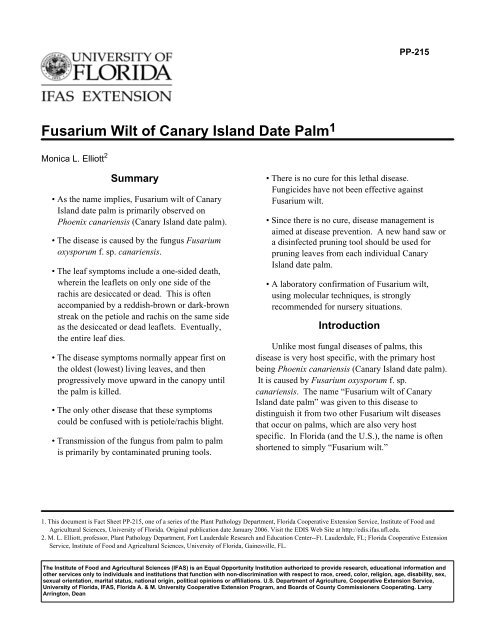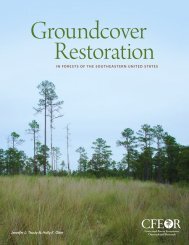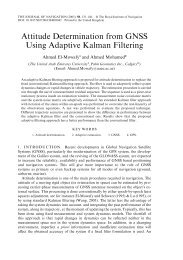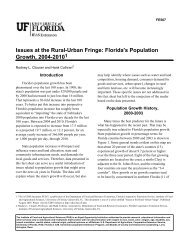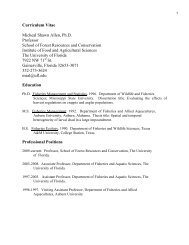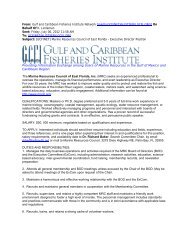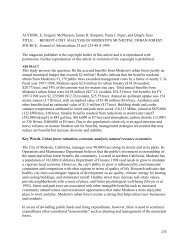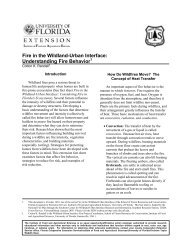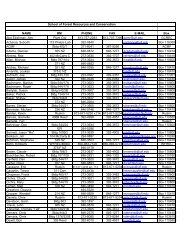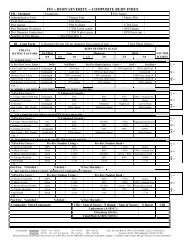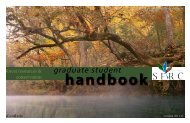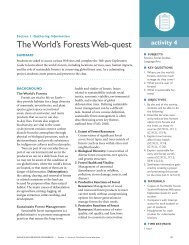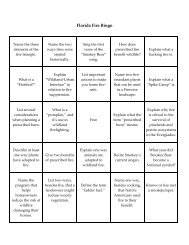Fusarium Wilt of Canary Island Date Palm1 - University of Florida
Fusarium Wilt of Canary Island Date Palm1 - University of Florida
Fusarium Wilt of Canary Island Date Palm1 - University of Florida
- No tags were found...
You also want an ePaper? Increase the reach of your titles
YUMPU automatically turns print PDFs into web optimized ePapers that Google loves.
PP-215<strong>Fusarium</strong> <strong>Wilt</strong> <strong>of</strong> <strong>Canary</strong> <strong>Island</strong> <strong>Date</strong> Palm 1Monica L. Elliott 2Summary• As the name implies, <strong>Fusarium</strong> wilt <strong>of</strong> <strong>Canary</strong><strong>Island</strong> date palm is primarily observed onPhoenix canariensis (<strong>Canary</strong> <strong>Island</strong> date palm).• The disease is caused by the fungus <strong>Fusarium</strong>oxysporum f. sp. canariensis.• The leaf symptoms include a one-sided death,wherein the leaflets on only one side <strong>of</strong> therachis are desiccated or dead. This is <strong>of</strong>tenaccompanied by a reddish-brown or dark-brownstreak on the petiole and rachis on the same sideas the desiccated or dead leaflets. Eventually,the entire leaf dies.• The disease symptoms normally appear first onthe oldest (lowest) living leaves, and thenprogressively move upward in the canopy untilthe palm is killed.• The only other disease that these symptomscould be confused with is petiole/rachis blight.• Transmission <strong>of</strong> the fungus from palm to palmis primarily by contaminated pruning tools.• There is no cure for this lethal disease.Fungicides have not been effective against<strong>Fusarium</strong> wilt.• Since there is no cure, disease management isaimed at disease prevention. A new hand saw ora disinfected pruning tool should be used forpruning leaves from each individual <strong>Canary</strong><strong>Island</strong> date palm.• A laboratory confirmation <strong>of</strong> <strong>Fusarium</strong> wilt,using molecular techniques, is stronglyrecommended for nursery situations.IntroductionUnlike most fungal diseases <strong>of</strong> palms, thisdisease is very host specific, with the primary hostbeing Phoenix canariensis (<strong>Canary</strong> <strong>Island</strong> date palm).It is caused by <strong>Fusarium</strong> oxysporum f. sp.canariensis. The name “<strong>Fusarium</strong> wilt <strong>of</strong> <strong>Canary</strong><strong>Island</strong> date palm” was given to this disease todistinguish it from two other <strong>Fusarium</strong> wilt diseasesthat occur on palms, which are also very hostspecific. In <strong>Florida</strong> (and the U.S.), the name is <strong>of</strong>tenshortened to simply “<strong>Fusarium</strong> wilt.”1. This document is Fact Sheet PP-215, one <strong>of</strong> a series <strong>of</strong> the Plant Pathology Department, <strong>Florida</strong> Cooperative Extension Service, Institute <strong>of</strong> Food andAgricultural Sciences, <strong>University</strong> <strong>of</strong> <strong>Florida</strong>. Original publication date January 2006. Visit the EDIS Web Site at http://edis.ifas.ufl.edu.2. M. L. Elliott, pr<strong>of</strong>essor, Plant Pathology Department, Fort Lauderdale Research and Education Center--Ft. Lauderdale, FL; <strong>Florida</strong> Cooperative ExtensionService, Institute <strong>of</strong> Food and Agricultural Sciences, <strong>University</strong> <strong>of</strong> <strong>Florida</strong>, Gainesville, FL.The Institute <strong>of</strong> Food and Agricultural Sciences (IFAS) is an Equal Opportunity Institution authorized to provide research, educational information andother services only to individuals and institutions that function with non-discrimination with respect to race, creed, color, religion, age, disability, sex,sexual orientation, marital status, national origin, political opinions or affiliations. U.S. Department <strong>of</strong> Agriculture, Cooperative Extension Service,<strong>University</strong> <strong>of</strong> <strong>Florida</strong>, IFAS, <strong>Florida</strong> A. & M. <strong>University</strong> Cooperative Extension Program, and Boards <strong>of</strong> County Commissioners Cooperating. LarryArrington, Dean
<strong>Fusarium</strong> <strong>Wilt</strong> <strong>of</strong> <strong>Canary</strong> <strong>Island</strong> <strong>Date</strong> Palm 2"<strong>Fusarium</strong> wilt <strong>of</strong> date palm" (also calledBayoud disease) only occurs on Phoenix dactylifera,and thus far is restricted to Morocco and Algeria. Itis caused by <strong>Fusarium</strong> oxysporum f. sp. albedinis."<strong>Fusarium</strong> wilt <strong>of</strong> oil palm" only occurs on Elaeisguineenis and Elaeis oleifera, and thus far is restrictedto countries in Central Africa and South America. Itis caused by <strong>Fusarium</strong> oxysporum f. sp. elaeidis.Pathogen and Hosts<strong>Fusarium</strong> wilt <strong>of</strong> <strong>Canary</strong> <strong>Island</strong> date palm iscaused by the fungus <strong>Fusarium</strong> oxysporum f. sp.canariensis. It was first documented in the U.S. inthe 1970s in California, but was not documented in<strong>Florida</strong> until 1994. The disease has been observed inAustralia, France, Greece, Italy and Japan.This fungus causes a vascular wilt <strong>of</strong> the palm.Specifically, it obstructs the xylem(water-conducting) tissue, which results in thesymptoms <strong>of</strong> desiccation and death described below.The fungus produces short-lived spores(macroconidia and microconidia). It also produceschlamydospores, spores that will live in the soil andplant tissue for long time periods (usually years).Because most <strong>of</strong> the root system is left behind after apalm dies from this disease, this mass <strong>of</strong> roots mayact as a reservoir for the fungus for long time periods.Experimental and observational evidencesuggests that other Phoenix species may besusceptible to this fungus, including Phoenixdactylifera (date palm), Phoenix reclinata (Senegaldate palm), and Phoenix sylvestris (wild date palm),but not Phoenix roebelenii (pygmy date palm).The disease has also been noted on Washingtoniafilifera (California fan palm) in one location each inCalifornia and Australia. Both these sites hadpreviously contained diseased <strong>Canary</strong> <strong>Island</strong> datepalms that died from <strong>Fusarium</strong> wilt. However, thefield diagnosis <strong>of</strong> <strong>Fusarium</strong> wilt-like symptoms onWashingtonia robusta (Mexican fan palm), a palmcommonly grown throughout <strong>Florida</strong>, can probablybe attributed to petiole/rachis blight. See the factsheet on this disease at http://edis.ifas.ufl.edu/pp145.From 1999 through 2004, the <strong>Florida</strong> ExtensionPlant Disease Clinic reported 71 palm samplespositive for <strong>Fusarium</strong> oxysporum f. sp. canariensis.Of these, 56 were Phoenix canariensis, 4 werePhoenix dactylifera, 1 was a Phoenix sylvestris, 5were unidentified Phoenix spp., 4 were palms <strong>of</strong>unknown genera (information not provided whensample submitted), and 1 was a Washingtoniarobusta. Thus, in <strong>Florida</strong>, as for most <strong>of</strong> the world,the vast majority <strong>of</strong> palms diagnosed with <strong>Fusarium</strong>wilt have been Phoenix canariensis.Palm AnatomyTo understand the symptoms described below,the terminology regarding palm anatomy must bedefined. Phoenix species are an example <strong>of</strong> a pinnateor feather-leaf palm. The entire leaf is <strong>of</strong>ten called afrond. The leaf consists <strong>of</strong> a blade, a petiole and aleaf base. The leaf base is the broad section thatattaches to the trunk. The petiole is the “stem” <strong>of</strong>the leaf from the leaf base to the point where leafletsbegin to attach to it. On a feather-leaf palm, theextension <strong>of</strong> the petiole into the leaf blade where allthe leaflets attach is called the rachis. The leaflets are<strong>of</strong>ten referred to as pinnae.SymptomsAlthough the name “<strong>Fusarium</strong> wilt” impliesthat the primary symptom will be a wilt, vascularwilts in palms do not cause wilt symptoms. Instead,they cause leaf desiccation and leaf death symptoms.As with any disease, a progression <strong>of</strong> symptoms isobserved with <strong>Fusarium</strong> wilt. Initial symptomsnormally occur on the lowest (oldest) living leaves.Leaflets, either all <strong>of</strong> them or only a portion, on onlyone side <strong>of</strong> the rachis will be discolored, usually ashade <strong>of</strong> brown due to desiccation or death. Theleaflets on the opposite side <strong>of</strong> the rachis will behealthy. This very distinctive symptom is <strong>of</strong>tenreferred to as a “one-sided wilt” or “one-sideddeath” (Figure 1). Eventually, the leaflets on theother side <strong>of</strong> the rachis will turn brown also, and theentire leaf dies.A reddish-brown or dark-brown streak or stripewill be observed on the petiole and rachis <strong>of</strong> theaffected frond, initially on the same side where thefirst dead leaflets appeared, and usually beginning at
<strong>Fusarium</strong> <strong>Wilt</strong> <strong>of</strong> <strong>Canary</strong> <strong>Island</strong> <strong>Date</strong> Palm 3Figure 2. Reddish-brown stripe on leaf petiole is on sameside that exhibited one-sided death <strong>of</strong> leaflets due to<strong>Fusarium</strong> wilt. Credits: N.A. HarrisonFigure 1. One-sided death <strong>of</strong> leaflets is typical <strong>of</strong><strong>Fusarium</strong> wilt. Credits: T.K. Broschator near the leaf base (Figure 2). This streak may runthe full length <strong>of</strong> the petiole and rachis, or just aportion <strong>of</strong> it. Internal discoloration will be observedin both cross-sections and longitudinal sections <strong>of</strong> thediscolored petiole and rachis (Figure 3). This internaldiscoloration is due to the fungus infesting the xylemtissue.The disease symptoms normally begin on thelowest (oldest) leaves and then move up the canopy,progressively killing younger and younger leaves(Figure 4). The palm may die relatively quickly(within months) or linger for a couple <strong>of</strong> years. Thereasons for this disparity is not known.Possible variations in symptoms include thedisease initially starting mid-canopy rather than at thebottom <strong>of</strong> the canopy. For some leaves, the leafletsmay begin turning brown at the leaf tip and on bothsides at once, rather than just on one side. It has alsoFigure 3. Longitudinal section <strong>of</strong> petiole illustrates thevascular discoloration due to infestation <strong>of</strong> xylem tissue by<strong>Fusarium</strong> oxysporum f. sp. canariensis. Credits: G.W.Simonebeen noted that the presence <strong>of</strong> palm weevils in thebud <strong>of</strong> <strong>Fusarium</strong> wilt-stressed palms hasten thedecline <strong>of</strong> the palm, and may complicate determiningthe cause <strong>of</strong> the palm's decline.DiagnosisField diagnosis can <strong>of</strong>ten be made based on thesymptoms described above, especially if thesymptoms are typical ones. The only other disease<strong>Fusarium</strong> wilt <strong>of</strong> <strong>Canary</strong> <strong>Island</strong> date palm might beconfused with is petiole/rachis blight. The latter isnot a true vascular wilt and usually does not kill thepalm, but the resulting individual leaf symptoms canbe very similar on a Phoenix species. See the factsheet on this disease at http://edis.ifas.ufl.edu/pp145.While a molecular laboratory diagnosis toconfirm the field diagnosis may not be a necessary
<strong>Fusarium</strong> <strong>Wilt</strong> <strong>of</strong> <strong>Canary</strong> <strong>Island</strong> <strong>Date</strong> Palm 4culture. Thus, isolation <strong>of</strong> a fungus that looks like F.oxysporum does not confirm the field diagnosis. Thefungus growing on the culture plate is then subjectedto a molecular test that is specific for F. oxysporum f.sp. canariensis.If the field symptoms appear typical for<strong>Fusarium</strong> wilt, but the molecular test results arenegative, then there are two things to consider. First,the symptoms may not be an expression <strong>of</strong> <strong>Fusarium</strong>wilt, but may be an expression <strong>of</strong> petiole/rachisblight. Many <strong>of</strong> the petiole/rachis blight pathogensare not culturable from plant tissue. Second, thesymptoms may be an expression <strong>of</strong> <strong>Fusarium</strong> wilt,but a false negative was obtained from the moleculartest. No diagnostic test is perfect every time.Figure 4. Progressive death <strong>of</strong> leaves up through thecanopy due to <strong>Fusarium</strong> wilt. Note that the right side <strong>of</strong> theupright leaf at top <strong>of</strong> canopy is exhibiting the one-sideddeath <strong>of</strong> leaflets typical <strong>of</strong> <strong>Fusarium</strong> wilt. Credits: T.K.Broschatexpense for a landscape situation, it is critical if thedisease symptoms are occurring in a palm nursery.To confirm the field diagnosis, a laboratory mustisolate the pathogen from the affected leaf tissue andthen conduct a molecular test on the isolated culture.Currently, only the <strong>Florida</strong> Extension Plant DiseaseClinic in Gainesville conducts this molecular test.Contact your local county Extension <strong>of</strong>fice or theClinic for complete details on correct samplesubmission procedures and cost <strong>of</strong> a laboratorydiagnosis.Molecular confirmation <strong>of</strong> the isolated fungus iscritical. There are numerous <strong>Fusarium</strong> oxysporumisolates that do not cause disease, but may beassociated with palm material. Unfortunately, it isnot possible to separate pathogenic isolates fromnon-pathogenic isolates based on their appearance inThe next step would be to obtain new samplesfrom the diseased palm or similarly diseased palmand resubmit to the Clinic for the molecular test forF. oxysporum f. sp. canariensis and to confirmpresence or absence <strong>of</strong> petiole/rachis blightpathogens. Be sure to discuss the problem with theclinic staff before resubmitting samples. If nosymptomatic leaves are available, wait until newsymptoms develop before resubmitting.Disease ManagementThere are no cures for this disease. Fungicideshave been evaluated, but none have been effective.Disease management is based solely on diseaseprevention.The fungus is moved between distant locationsby plant material, both live plants and probably seed.This is probably how the disease was first introduced(and re-introduced) into <strong>Florida</strong>. Unpublishedresearch from both <strong>Florida</strong> and Australia havedemonstrated the fungus can colonize palm seeds.This makes it critical for palm nurseries to know thattheir seed source and stock plants are coming from adisease-free source. Likewise, nursery growers,landscape architects and installation companiesshould examine and select <strong>Canary</strong> <strong>Island</strong> date palmswhile they are still in the field or on site at a containernursery and make this inspection prior to anytrimming <strong>of</strong> older leaves so the plants can beinspected for symptoms. Then, either monitor thetrimming <strong>of</strong> these palms to ensure they are trimmed
<strong>Fusarium</strong> <strong>Wilt</strong> <strong>of</strong> <strong>Canary</strong> <strong>Island</strong> <strong>Date</strong> Palm 5correctly, or trim them at the installation site usingthe correct procedure discussed below.Once the disease is established in a landscape ornursery, the disease appears to primarily betransmitted from palm to palm via leaf pruningequipment (Figure 5). The fungal pathogen is in thevascular tissue <strong>of</strong> the leaf. Equipment used to removeleaves from an infected <strong>Canary</strong> <strong>Island</strong> date palm(chain saw, lopper, pruning shear, hand saw, etc.) willhave fungal-infested leaf material (wood dust, plantsap) on the blades. If that equipment is not cleanedand disinfected, the next <strong>Canary</strong> <strong>Island</strong> date palm(and perhaps other Phoenix species) pruned by thisequipment will be exposed to this fungal-infested leafmaterial.It is important to note that a palm could beinfected but appear healthy (symptomless) becausethe disease has not developed to the point that leafsymptoms are being expressed. Unfortuantely, we donot know how long this infected but symptomlessstage <strong>of</strong> the disease lasts. It could be 6 to 18 months.Thus, the fungus could still be moved from palm topalm by pruning infected but symptomless leaves!This means <strong>Canary</strong> <strong>Island</strong> date palms should bepruned with either new handsaws or clean,disinfected tools – both in the landscape and nursery.This applies to all <strong>Canary</strong> <strong>Island</strong> date palms, diseasedand healthy. Either a new handsaw or a clean,disinfected pruning tool should be used for eachindividual palm. Pruning should be limited to onceeach year. Furthermore, pruning should be restrictedto removal <strong>of</strong> only dead or dying leaves. Severepruning, such as “hurricane cuts” or “pineapplecuts,” weakens trees and increases the risk <strong>of</strong>pathogen transmission. Pruning should be viewed asa risk factor for <strong>Fusarium</strong> wilt disease transmission,and not as a benefit to the <strong>Canary</strong> <strong>Island</strong> date palm.Table 1 is a list <strong>of</strong> materials that can be used asdisinfecting agents. Brush the tool blades clean <strong>of</strong>debris before placing in the disinfectant solution. Forchain saws, it is recommended that they be takenapart and both the chain and bar soaked. By havingmultiple pruning tools, one tool can be soaking in thedisinfectant solution while the other tool is used forpruning. The disinfectant solution should be replacedat least every ten trees or every two hours. Rinsetools with clean water before pruning.The following is a management suggestion. Forthe initial installation <strong>of</strong> a <strong>Canary</strong> <strong>Island</strong> date palm, itis normal to remove a large number <strong>of</strong> fronds. Usinga handsaw would be time consuming. So, either use anew chainsaw or disinfect the chainsaw between eachpalm. Thereafter, the number <strong>of</strong> leaves prunedshould be limited as only dead leaves should beremoved. This can be accomplished with a newhandsaw for each palm.While this is an extraordinary measure, it isinexpensive disease prevention management forextremely valuable palms. A mature <strong>Canary</strong> <strong>Island</strong>date palm that has died from <strong>Fusarium</strong> wilt isexpensive to remove and expensive to replace. It iscertainly more economical to prevent the disease thandeal with the deadly consequences, especially if thereare multiple <strong>Canary</strong> <strong>Island</strong> date palms in thelandscape (Figure 5). Using a new handsaw ordisinfecting the pruning tool is inexpensive incomparison to a devastated landscape.Figure 5. Multiple Phoenix canariensis dying from<strong>Fusarium</strong> wilt. The disease is moved from palm to palm byinfested pruning tools. Credits: H.M. DonselmanAgain, this is a disease without a cure. In anursery situation, diagnosis <strong>of</strong> this disease effectivelydestroys the crop as the plants are unsaleable andmust be destroyed. In the landscape situation, thepalm will eventually die and have to be removed. Inboth situations, but especially the nursery situation,the diseased palm(s) should be removed anddestroyed immediately. Be very careful not todistribute potentially fungal-infested soil or potting
<strong>Fusarium</strong> <strong>Wilt</strong> <strong>of</strong> <strong>Canary</strong> <strong>Island</strong> <strong>Date</strong> Palm 6mix in the nursery. Surrounding <strong>Canary</strong> <strong>Island</strong> datepalms should be monitored closely, as it is quitelikely the entire crop could be infected.The diseased palm should be incinerated orplaced in a landfill. If this is not possible (as is thecase in many <strong>Florida</strong> counties), then be sure the palmis not chipped and recycled for mulch in thelandscape. Instead, chipped material should beplaced in a compost pile. Chain saws and other toolsused for removal must be brushed free <strong>of</strong> plantmaterial and disinfected as described previously.Chlamydospores <strong>of</strong> <strong>Fusarium</strong> oxysporum f. sp.canariensis can survive for long periods in the soil,and certainly will survive in any infected root massleft behind when a diseased palm is removed.Experimental and observational evidence has shownthe potential for infecting palms, especially seedlingpalms, with this fungus via the root system.Therefore, it would not be prudent to plant a <strong>Canary</strong><strong>Island</strong> date palm back into a site where <strong>Fusarium</strong> wilthad killed the previous palm(s). It is not known howfar away from the potentially fungal-infested site onemust move before it is safe to plant a <strong>Canary</strong> <strong>Island</strong>date palm, or other potentially susceptible Phoenixspecies.Selected References<strong>University</strong> <strong>of</strong> <strong>Florida</strong>, Cooperative ExtensionService, Gainesville, FL.Simone, G. W. 2004. <strong>Fusarium</strong> wilt. Pages17-25 in: Compendium <strong>of</strong> Ornamental PalmDiseases and Disorders. M. L. Elliott, T. K.Broschat, J. Y. Uchida, and G. W. Simone, eds.American Phytopathological Society, St. Paul,MN.Simone, G. W. and G. Cashion. 1996. <strong>Fusarium</strong><strong>Wilt</strong> <strong>of</strong> <strong>Canary</strong> <strong>Island</strong> <strong>Date</strong> Palms in <strong>Florida</strong>.Plant Pathology Fact Sheet PP-44. <strong>University</strong> <strong>of</strong><strong>Florida</strong>, Cooperative Extension Service,Gainesville, FL.Smith, D.I., I.W. Smith and P. Clements. 2003.<strong>Fusarium</strong> <strong>Wilt</strong> <strong>of</strong> <strong>Canary</strong> <strong>Island</strong> <strong>Date</strong> Palm.Forests Fact Sheet, Department <strong>of</strong> Sustainabilityand Environment, Victoria, Australia.Summerell, B. A., H. C. Kistler, and L. V. Gunn.2001. <strong>Fusarium</strong> wilt <strong>of</strong> Phoenix canariensiscaused by <strong>Fusarium</strong> oxysporum f. sp.canariensis. Pages 263-270 in: <strong>Fusarium</strong>: PaulE. Nelson Memorial Symposium. B. A.Summerell, J. F. Leslie, D. Backhouse, W. L.Bryden, and L. W. Burgess, eds. AmericanPhytopathological Society, St. Paul, MN.Feather, T. V. 1982. Occurrence, Etiology andControl <strong>of</strong> <strong>Wilt</strong> and Dieback <strong>of</strong> Phoenixcanariensis in California. Ph.D. diss. <strong>University</strong><strong>of</strong> California, Riverside, CA.Feather, T. V., D. E. Munnecke, and J. B.Carpenter. 1989. The occurrence <strong>of</strong> <strong>Fusarium</strong>oxysporum on Phoenix canariensis, a potentialdanger to date production in California. PlantDisease 73:78-80.Plyler, T. R., G. W. Simone, D. Fernandez, andH. C. Kistler. 1999. Rapid detection <strong>of</strong> the<strong>Fusarium</strong> oxysporum lineage containing the<strong>Canary</strong> <strong>Island</strong> date palm wilt pathogen.Phytopathology 89:407-413.Simone, G. W. 1998. Prevention andManagement <strong>of</strong> Palm Diseases in <strong>Florida</strong>'sLandscapes. Plant Pathology Mimeo 98-4.
<strong>Fusarium</strong> <strong>Wilt</strong> <strong>of</strong> <strong>Canary</strong> <strong>Island</strong> <strong>Date</strong> Palm 7Table 1. Suggested materials and soaking times for disinfecting pruning tools.Material z % Solution Soaking timeHousehold bleach (ex: Chlorox) 25% (1 part bleach + 3 parts water) 5 minutes minimumPine oil cleaner (ex: Pine Sol) 25% (1 part cleaner + 3 parts water) 5 minutes minimumRubbing alcohol (70% isopropyl) 50% (1 part alcohol + 1 part water) 5 minutes minimumDenatured ethanol (95%) 50% (1 part alcohol + 1 part water) 5 minutes minimumzThe above materials were shown to be effective in eliminating the fungus from the wood dust or palm sap trapped onpruning tools (Simone, 1998). It is suggested that the solution be replaced after ten trees or every two hours. Rinse thetool with fresh water after soaking. Other potential disinfectants would be trisodium phosphate or quaternary ammoniumsalts. The latter is recommended at a 5% solution, soaking for 5 minutes (Smith et al., 2003).


